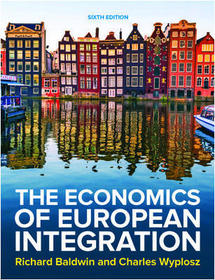
The Economics of European Integration 6e
- Publisher's listprice GBP 64.99
-
31 048 Ft (29 570 Ft + 5% VAT)
The price is estimated because at the time of ordering we do not know what conversion rates will apply to HUF / product currency when the book arrives. In case HUF is weaker, the price increases slightly, in case HUF is stronger, the price goes lower slightly.
- Discount 10% (cc. 3 105 Ft off)
- Discounted price 27 944 Ft (26 613 Ft + 5% VAT)
Subcribe now and take benefit of a favourable price.
Subscribe
31 048 Ft

Availability
Out of print
Why don't you give exact delivery time?
Delivery time is estimated on our previous experiences. We give estimations only, because we order from outside Hungary, and the delivery time mainly depends on how quickly the publisher supplies the book. Faster or slower deliveries both happen, but we do our best to supply as quickly as possible.
Product details:
- Edition number 6
- Publisher McGraw Hill
- Date of Publication 5 April 2019
- ISBN 9781526847218
- Binding Paperback
- No. of pages pages
- Size 247x190x20 mm
- Weight 895 g
- Language English 0
Categories
Long description:
Now in its sixth edition, The Economics of European Integration is a timely and insightful text on this everchanging
and controversial topic. This edition guides the students through the facts, theories, history, institutions,
laws, politics and policies of the European Union, and how each of these play their role in European economics.
Covering both the microeconomics and macroeconomics of European integration, this text is written for
second and third-year undergraduates in economics as well as advanced undergraduates and graduate
students in business, international affairs, European studies and political science.
This edition has now been updated to include two new chapters: The Economics of Covid-19 and Brexit: Problems and Prospects. These chapters can be downloaded on our Online Learning Centre and is available as part of the eBook.
Now in its sixth edition, The Economics of European Integration is a timely and insightful text on this everchanging
and controversial topic. This edition guides the students through the facts, theories, history, institutions,
laws, politics and policies of the European Union, and how each of these play their role in European economics.
Covering both the microeconomics and macroeconomics of European integration, this text is written for
second and third-year undergraduates in economics as well as advanced undergraduates and graduate
students in business, international affairs, European studies and political science.
This edition has now been updated to include two new chapters: The Economics of Covid-19 and Brexit: Problems and Prospects. These chapters can be downloaded on our Online Learning Centre and is available as part of the eBook.
Table of Contents:
Part I
- History, Facts and Institutions
Chapter 1. History
Chapter 2. Facts, law, institutions and the budget
Chapter 3. Decision making
Part II
- The Microeconomics of European Integration
Chapter 4. Essential microeconomic tools and tariff analysis
Chapter 5. The essential economics of preferential liberalization
Chapter 6. Market size and scale effects
Chapter 7. Growth effects and factor market integration
Chapter 8. Economic integration, labour markets and migration
Part III
- EU Micro Policies
Chapter 9. The common agricultural policy
Chapter 10. Location effects, economic geography and regional policy
Chapter 11. EU competition and state aid policy
Chapter 12. EU trade policy
Part IV
- The Macroeconmics of Monetary Integration
Chapter 13. Essential macroeconomic tools
Chapter 14. The history of European monetary integration
Chapter 15. Optimum currency areas
Part V
- EU Monetary and Fiscal Policies
Chapter 16. The European monetary union
Chapter 17. Fiscal policy and the Stability Pact
Chapter 18. The financial markets and the euro
Chapter 19. The Eurozone in crisis
Chapter 20. The Economics of Covid
-19 (Online Chapter)
Chapter 21. Brexit: Problems and Prospects (Online Chapter)





